By enabling encounters with the particularities of places and real things, museums are uniquely able to help people respond in useful ways to the monumental challenges of anthropogenic climate change.[1] The Waterhole Project — a research initiative that I developed as a curator at the National Museum of Australia — investigates the global problem of anthropogenic climate change from a grounded perspective of place and materiality. The project builds on my PhD research into the environmental history of the south-west slopes of New South Wales, a productive farming region west of Canberra.[2]
Encountering the Combaning waterhole
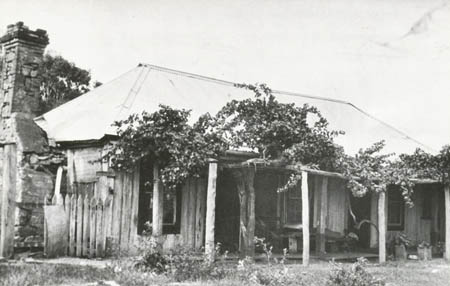
The Waterhole Project considers the meanings of climate change in relation to a particular place on the south-west slopes called Combaning. Combaning was the name given to an early squatting run established on Combaning Creek in the 1840s. Ten years ago, when conducting PhD fieldwork, I visited the site of Combaning homestead. Only the base of its stone chimney remained standing.
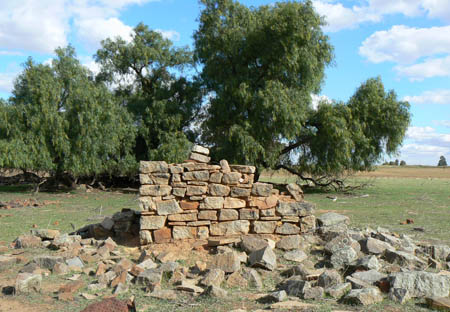
On that sunny autumn day, standing at the homestead site beside the chimney stones, I noticed some large eucalypts, possibly river red gums, on the banks of the nearby creek, and a hillside falling sharply into the waterway. I walked across the paddock to the creek, and encountered a waterhole.
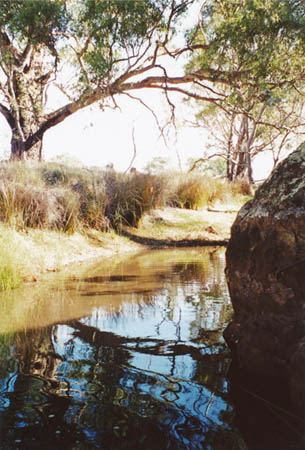
Seeing the small body of fresh water, I realised that it had enabled the establishment of Combaning homestead in the paddock nearby. I also recognised that the waterhole would probably have been significant to the local Wiradjuri people, for both practical and religious reasons. The place name Combaning is adapted from a Wiradjuri word that means, according to one early source, 'to hold water'.[3] Francis Woolrych worked as a surveyor in the Combaning area during the squatting period. 'When the white settlers overran the country', he wrote, 'they appropriated all the finest waterholes for their head stations, consequently these occupy what were at that time the chief camping grounds of the blackfellow'.[4]
Walking back to my car, the waterhole seemed forlorn, a place with multiple dimensions of significance, neglected and forgotten. Combaning is a good distance from the town of Temora to the west, and even further from Cootamundra to the east. There are no farmhouses nearby. In the nineteenth century, the killing and dispossession of Wiradjuri severed memory and people from this place. Over the last half century, as average farm sizes grew and labour costs rose, rural depopulation further undermined knowledge of the waterhole and its stories.
For several years, memories of this encounter with the waterhole at Combaning sat at the back of my mind. Then in 2009 I was trying to develop a research project that explored the historical and cultural dimensions of anthropogenic climate change within the context of place. I was thinking that the consideration of this global issue in local terms might provide useful insights into the meanings of the profound climatic and ecological changes that we're now living through, and might help in some small way to guide our responses. Eventually I decided that a research project centred on the Combaning waterhole presented opportunities to reflect on the meanings of climate change, especially in relation to the wellbeing of productive country. Water enables life and wellbeing, and its supply depends on climate patterns. Much of our concerns about climate change revolve around water, its scarcity or over abundance, and the implications of fluctuating supply for the productivity of farming and grazing land.
After I'd developed some ideas about how I might construct a project about climate change around the Combaning waterhole, I visited the site again with Bob Glanville, a widely respected Wiradjuri elder from Cootamundra whom I'd worked closely with while undertaking my PhD. I had wanted to make sure that he was comfortable with my developing a project around a place that was probably of particular significance to Wiradjuri people in the past, and today. Luckily he thought it was a good idea.
Some people might question whether the National Museum of Australia has a role to play in public and scholarly discussions about climate change. 'The public tends to define climate as the domain of the natural and physical sciences,' observes the environmental historian Tom Griffiths, 'and yet the greatest challenges in this area are political, cultural, social, psychological and emotional.' Climate change 'is not just a technical issue', he continues, 'it implicates and challenges our humanity'.[5] Museum consultant Robert Janes argues that museums need to transform their 'public service persona, defined by education and entertainment, to one of a locally-embedded problem solver, in tune with the challenges and aspirations of the community'.[6] Opportunities exist for the Museum to heighten its relevance to the Australian community by helping people wrestle with the historical, cultural and emotional dimensions of climate change.
While government and industry are directing plenty of resources towards investigating the scientific and technical aspects of climate change, few resources support projects that enable critical reflection on the historically and culturally determined ways of thinking and acting that have generated climate change, and which continue to block effective responses to the issue. And relatively few resources are being directed towards the development of alternative ways of thinking about ourselves and about our places, towards the encouragement of hopeful ways of thinking and acting that can build social and ecological resilience as we enter uncertain and difficult times.
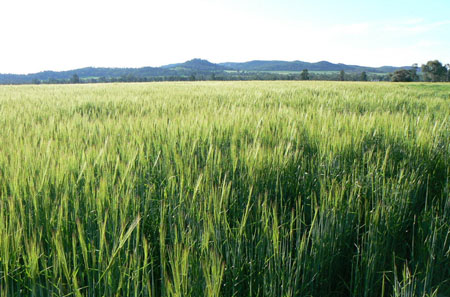
Combaning Creek weaves through some of the most productive grain, meat and wool producing country in Australia. Over generations, the district has nourished thousands, probably millions of people here and abroad, and kept their bodies warm with wool. Ecological philosopher Val Plumwood evocatively described as 'shadow places' those unseen terrains 'that provide our material and ecological support' and 'which, in a global market, are likely to elude our knowledge and responsibility'.[7] The productive lands of Combaning can be considered one such 'shadow place'. Modern methods of agricultural production, processing and marketing ensure that very few people are able to know this particular terrain that gives them life, or reciprocate the wellbeing it provides.
Connectivity and climate change
To connect people with a waterhole, a paddock, a creek — with the histories and material realities of one of the many productive places in which we are ecologically embedded — raises possibilities both frightening and empowering, as anthropologist Deborah Rose explains:
It frightens us because it brings us into embodied dialogue with the results of the very histories we might wish to forget, and into the presence of the people and places we have harmed. It refuses isolation, reveals our vulnerability, and suggests that neither people nor country whose interpenetrative lives are set in real time can afford to harm each other. By the same token, connectivity is potentially empowering. It enables a becoming that calls us to take care of the places and people with whom we are connected. It offers an expanded concept of self, and thus an expanded concept of self-interest.[8]
Storytelling and visual imagery accessed on The Waterhole Project website bring people into imaginative relationships with land and people, and allow them to witness suffering caused by climate change. The project attempts to banish the shadows cast by industrial modernity across the Combaning district by emphasising our material, ecological ties to one of the many productive rural places that nourish us. Research findings are presented online, in a blog format. Readers are invited to respond, to add their own ideas and stories. Links are presented to other institutions and bodies of knowledge. The site features contemporary photos taken during fieldwork, and historical images.
The style, method and structure of the research and its online presentation support an argument about how we might respond to the crisis of climate change. The web structure of the blog format, the use of links and images, enables a sense of connectivity and implies that in the face of climate change, ecological and social resilience depend on the forging of relationships. 'Climate change', observes cultural historian Kate Rigby, 'challenges us to explore ways of thinking and acting that depart from the mainline of modernity, calling us into relationship with others across the boundaries of 'race', class, religion, nation and species: unless we can respond to this call on a collective level, we are likely to descend into the most appalling barbarism.'[9]
Stories told by pastoral worker John McGuire reveal ties between the Combaning region, a collection held by the National Museum of Australia, and the issue of climate change. McGuire was 10 years old when he ran away from Sydney and headed west over the Blue Mountains.[10] He found work on Carrawobbity, a squatting run on the Lachlan River, north of Combaning. It was 1836, and Carrawobbity lay on the edge of the pastoral frontier. When a stockman abandoned McGuire and an Aboriginal boy on a distant part of the vast station, they joined a Wiradjuri clan. 'I spent three years amongst the wild blacks of the Lachlan River', McGuire later recalled, 'without seeing a white person during the whole of that period, so that I had almost become one of themselves.' Half a century later, as an old man living in Junee, a town south of the Lachlan, McGuire yarned at length with a local newspaper editor, who recorded and published McGuire's accounts of frontier life.
In the 1840s, downstream from Combaning, near Lake Cowal, squatters coordinated their efforts to defend themselves from Wiradjuri people. John McGuire recalled how four stations to the south of Lake Cowal built huts in adjacent corners of the runs, for purposes of protection from Aboriginal attack. Billabong station was one of the four properties, and during this time of conflict McGuire managed the station for an absentee squatter.
A century later, the Sanderson family held Billabong station. In 1939 Elizabeth Sanderson, then a young woman, bought a pair of high-heeled satin shoes in London, at the exclusive Harrods store. The shoes were part of an outfit, now held by the National Museum of Australia, that Sanderson wore for her presentation to King George at Buckingham Palace. In her diary Elizabeth Sanderson described her presentation amid the splendour of Buckingham Palace as 'the most thrilling and wonderful event of my life'.[11]
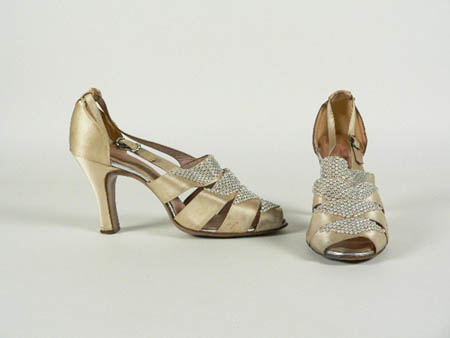
Last year I drove through a property near Billabong station, on the Bland Creek upstream. I stopped to photograph the remains of two old eucalyptus trees that the landholder had recently bulldozed. Once he'd burned away the trunks and branches, nothing would remain to obstruct the passage of his massive farming equipment. Ecologists explain how the ongoing fragmentation of a local ecology, as shown in the photograph below, makes land less resilient to extreme weather events and other shocks. As climate patterns become increasingly chaotic, we need more connectivity and the resilience it brings, not less.
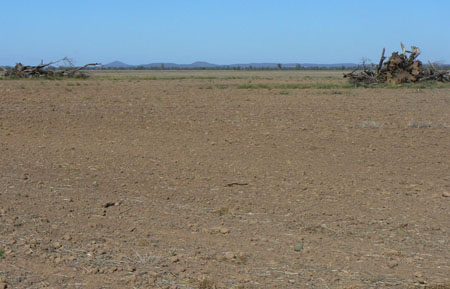
Valuing the local and particular
The collection associated with Elizabeth Sanderson provides insights into the cultural dynamics that enable ecological destruction and weakening. Since the colonisation of Australia began in the late eighteenth century, cultural processes operating in settler society often cast a distant place, Britain, the colonial centre, as the primary source of value and significance. Such processes devalued local particularities and favoured powerful demands and interests arising in faraway places. In the past and today, market forces emanating from urban centres tend to give commercial demands priority above the ecological needs of rural places, and depend on the devaluing and erasure of local particularities.
Museums offer more than understandings about problematic cultural processes of colonisation. By enabling encounters with the material particularities of places and their objects, museums and other cultural institutions engender a way of knowing that counters destructive colonial dynamics and fosters useful responses to the crisis of climate change. Honouring and foregrounding place and materiality challenges modern, universalist ways of knowing. Places are not interpreted as case studies, as keys to abstract, generalised forms of knowledge. Instead, places and their things are presented to museum visitors as invitations to engage with the unique particularities of the world. On offer is a democratic form of knowledge, whereby a person can generate their own meanings through the engagement of their own sensing bodies, as well as their minds, with materiality.
Visitors are empowered when museums allow them to make their own meanings through an engagement with the real. The philosopher David Abram argues that: 'We are by now so accustomed to the cult of expertise that the very notion of honouring and paying heed to our directly felt experience of things — of insects and wooden floors, of broken-down cars and bird-pecked apples and the scents rising from the soil — seems odd and somewhat misguided as a way to find out what's worth knowing. According to assumptions long held by [Western] civilization', he continues, 'the deepest truth of things is concealed behind the appearances, in dimensions inaccessible to our senses.'[12]
Stories, representations and other cultural processes that devalue the local and the particular serve industrial development at great cost. The material terrains our bodies directly experience, 'rippling with cricket rhythms and scoured by the tides', writes David Abram, 'is the very realm now most ravaged by the spreading consequences of our disregard'.[13]
Freya Mathews, another philosopher whose thoughts are useful here, argues that the adoption of a universal perspective, a framework that retreats from the particularity of things, denies the subjectivity of others and refuses dialogue. 'This is because the subjectivity of others is communicated to us via particulars', she writes. 'Communicative cues reside deep within the particularity of things: communicative intent is recognisable only at the level of the particular instance, at those junctures at which behaviour departs from an anticipated norm.'[14]
'To initiate communication [with the world at large]', she continues, 'we must address it at the level of particulars. This requires awareness of intricate patterns of unfolding, attunement to the minutest details in the order and sequence of things; we must be prepared to pay attention to things in their infinite variability.'
Museums are uniquely positioned to foster the sort of attunement to particularity that Mathews advocates. By enabling encounters with particular, material things, and with the people, places and other species to which those things are connected, museums enable dialogue and the witnessing of suffering. Dialogue and witnessing give people opportunities to respond, to build the social and ecological links that provide resilience and hope in a time of crisis.
1 This article is adapted from a staff seminar presented at the National Museum of Australia on 24 May 2011.
2 My PhD thesis was published by UNSW Press in 2005 as Heartland: The Regeneration of Rural Place.
3 James Tyrrell, Australian Aboriginal Place Names, Simmons, Sydney, 1933.
4 Francis Woolrych, 'Native names of some of the runs &c. in the Lachlan district', Journal and Proceedings of the Royal Society of NSW, vol. 24, 1890 (p. 63).
5 Tom Griffiths, 'A humanist on thin ice', Griffith Review, edition 29, 2010.
6 Robert R Janes, Museums in a Troubled World, Routledge, London, 2009, p. 173.
7 Val Plumwood, 'Shadow places and the politics of dwelling', Australian Humanities Review, number 44, March 2008.
8Deborah Rose, 'Dialogue with place: Toward an ecological body', Journal of Narrative Theory, autumn 2002 (p. 322).
9 Kate Rigby, 'Dancing with disaster', Australian Humanities Review, number 46, (p. 139).
10 WH Pinkstone, 'Early colonial days: The biography of a reliable old native John McGuire', about 1901, National Library of Australia.
11Internal file, National Museum of Australia.
12David Abram, Becoming Animal: An Earthly Cosmology, Pantheon, New York, 2010, p. 4.
13Abram, Becoming Animal, p. 6.
14Freya Mathews, Reinhabiting Reality: Towards a Recovery of Culture, UNSW Press, Sydney, 2005, p. 16.
